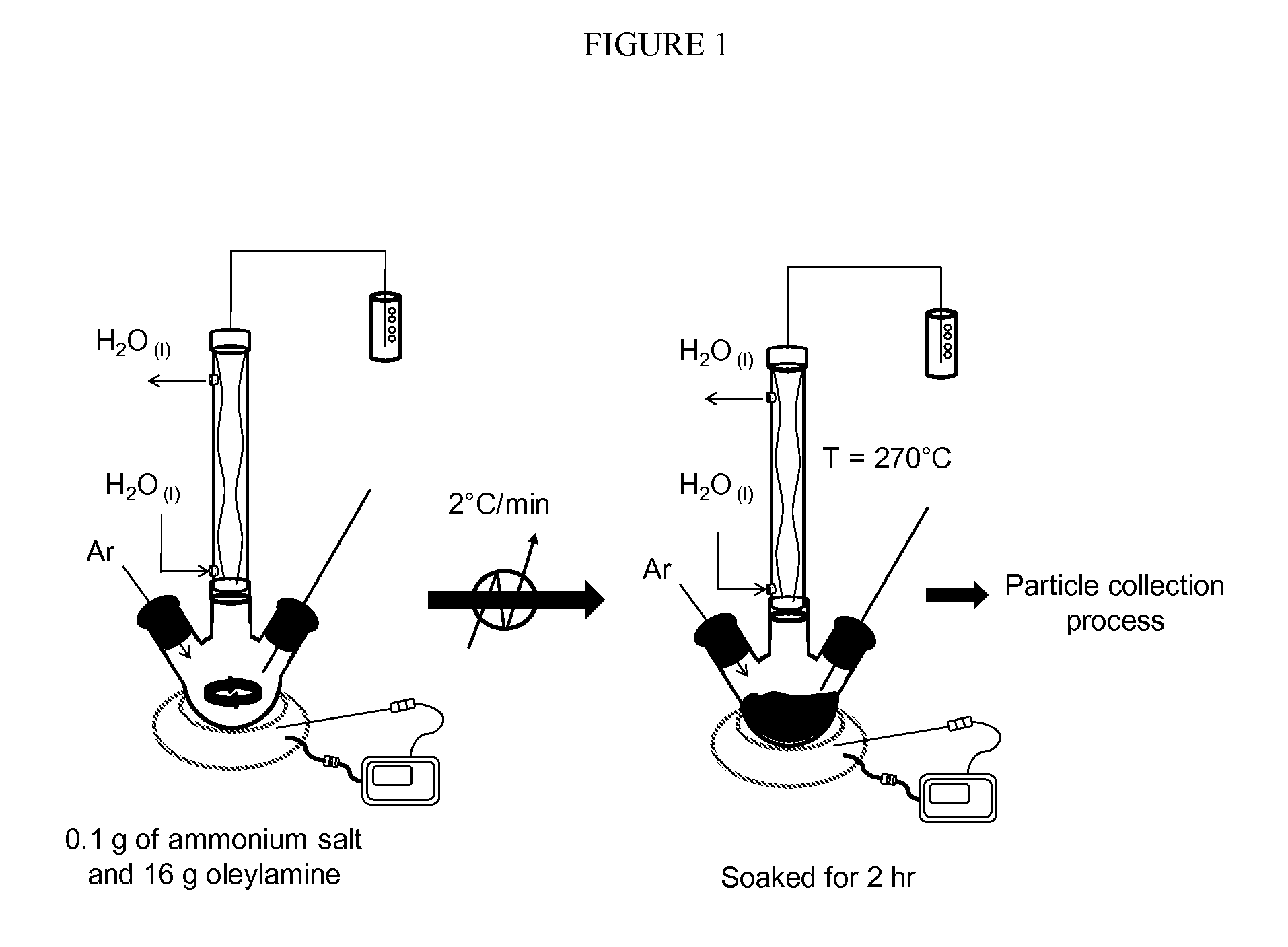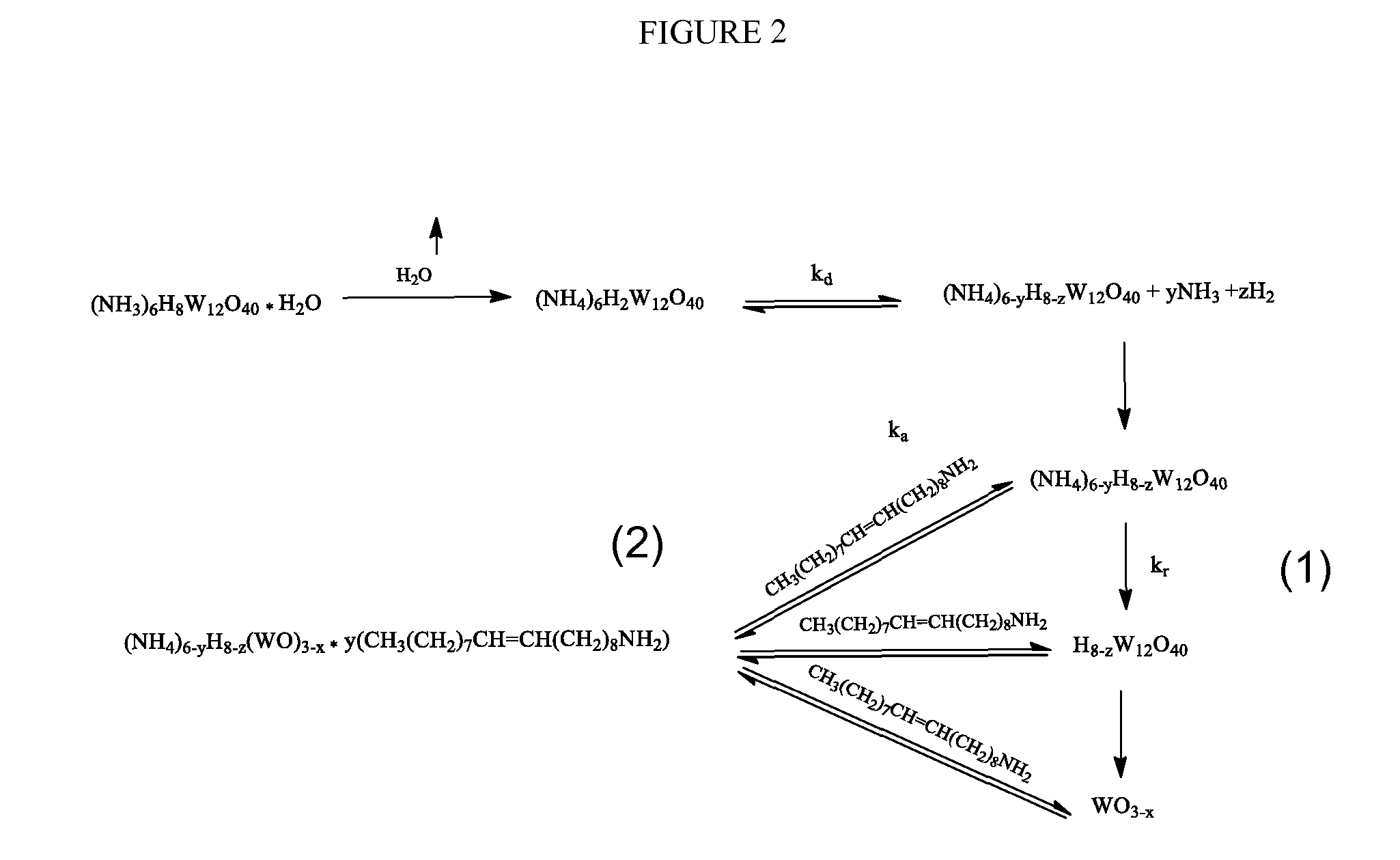Synthesis of ultrasmall metal oxide nanoparticles
a technology of metal oxide and nanoparticles, which is applied in the direction of metal/metal-oxide/metal-hydroxide catalysts, catalyst activation/preparation, physical/chemical process catalysts, etc., can solve the problems of inability to synthesize ultrasmall molybdenum oxide, and all the above methods for synthesizing vanadium and molybdenum nanoparticles were incapable of synthesizing ultrasmall nanoparticles, and achieve great ca
- Summary
- Abstract
- Description
- Claims
- Application Information
AI Technical Summary
Benefits of technology
Problems solved by technology
Method used
Image
Examples
example 1
[0048]Selection of the ammonium salt metal precursor. The selection of the ammonium salt metal precursor that is water-soluble and not organic-soluble is quite important, because otherwise the use of an organic solvent will prevent the synthesis of ultrasmall nanoparticles due to the dissolution of the metal or MOx precursor.
[0049]Generally, the precursor should be fully oxidized and have structural stability up to about 260° C. due to its Keggin structure conformation. Keggin structure is the best known structural form for heteropoly acids. It is the structural form of α-Keggin anions, which have a general formula of [XM12O40]n-, where X is the heteroatom (most commonly are P5+, Si4+, or B3+ or simply H+), M is the addenda atom (most common are molybdenum and tungsten), and O represents oxygen. The structure self-assembles in acidic aqueous solution and is the most stable structure of polyoxometalate catalysts. At about 250° C. the precursor Keggin structure co...
example 2
Characterization of Metal Oxides
[0060]To determine the particle composition and morphology the following characterization tools were used.
[0061]TEM-STEM. Bright field (BF) images and selective area diffraction (SAD) of the samples were obtained using a JEOL 2000FX TEM operating at 200 kV. High resolution TEM (HRTEM) imaging were performed on a 200 kV JEOL 2200FS (S)TEM equipped with a CEOS probe Cs-corrector.
[0062]AFM Atomic force microscopy (AFM) measurements were performed on a digital instrument (Nanoscope IIIA). Toluene dispersed nanoparticles were deposited and spin-coated onto high ordered pyrolytic graphite (HOPG) for optimal dispersion properties. The HOPG surface was completely flat with variations<1 nm along the vertical z-axis making it easy to detect smaller particles.
[0063]TGA. Thermogravimetric analysis was performed on a Q600 TA instrument that allowed us to calculate the organic content of the particles. All samples were previously dried at room temperature overnight...
example 3
Propylene Metathesis
[0077]Olefin metathesis is a popular and useful reaction. In the presence of certain transition-metal compounds, olefins exchange the groups around the double bonds, resulting in several outcomes: straight swapping of groups between two acyclic olefins (cross-metathesis), closure of large rings (ring-closing metathesis), formation of dienes from cyclic and acyclic olefins (ring-opening metathesis), polymerization of cyclic olefins (ring-opening metathesis polymerization), and polymerization of acyclic dienes (acyclic diene metathesis polymerization).
[0078]WOx on SiO2 supports have been extensively investigated as catalysts for metathesis reactions due to their increased selectivity, resistance to poisoning and their ease in regeneration. However, conventional synthesis techniques lack control over delivering high concentrations of tetrahedrally coordinated WOx monomers and oligomers (Lewis acid sites) that are responsible for high metathesis activity. Thus, we so...
PUM
| Property | Measurement | Unit |
|---|---|---|
| Temperature | aaaaa | aaaaa |
| Temperature | aaaaa | aaaaa |
| Fraction | aaaaa | aaaaa |
Abstract
Description
Claims
Application Information
 Login to View More
Login to View More - R&D
- Intellectual Property
- Life Sciences
- Materials
- Tech Scout
- Unparalleled Data Quality
- Higher Quality Content
- 60% Fewer Hallucinations
Browse by: Latest US Patents, China's latest patents, Technical Efficacy Thesaurus, Application Domain, Technology Topic, Popular Technical Reports.
© 2025 PatSnap. All rights reserved.Legal|Privacy policy|Modern Slavery Act Transparency Statement|Sitemap|About US| Contact US: help@patsnap.com



